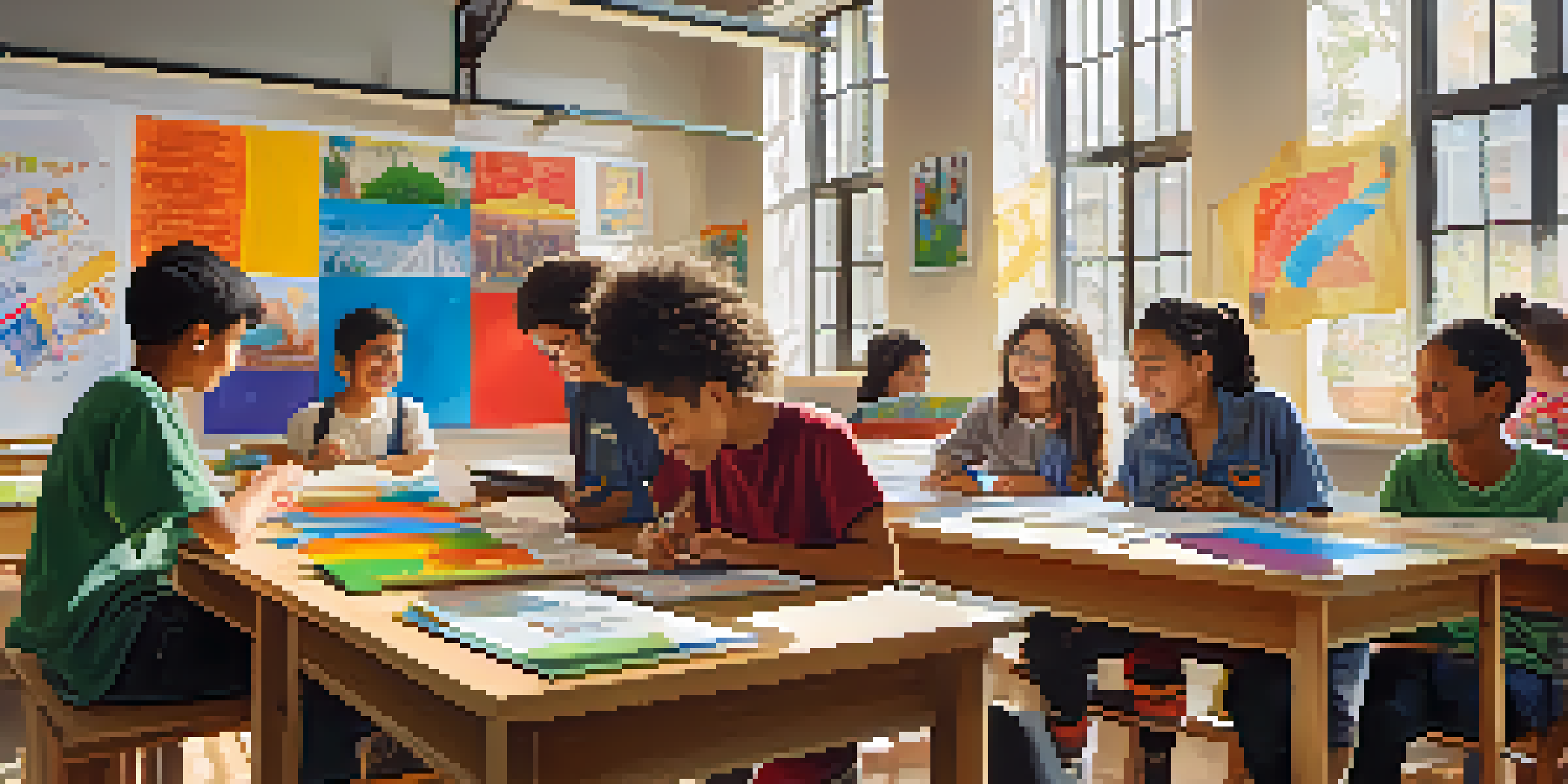Exploring the Impact of Cultural Diversity on Student Engagement

Understanding Cultural Diversity in Education
Cultural diversity refers to the variety of cultural or ethnic groups within a society. In educational settings, this encompasses students from different backgrounds, traditions, and perspectives. It's essential to recognize that each student's unique cultural identity can enrich the learning environment.
Diversity is not a reason to be fearful; it is a reason to celebrate.
When classrooms reflect a mix of cultures, they become vibrant spaces where students can learn from one another. This diversity allows for a more comprehensive understanding of global issues, fostering empathy and respect. In essence, a culturally diverse classroom is a microcosm of the world, preparing students for future interactions.
Moreover, embracing cultural diversity in education can lead to more inclusive teaching practices. Educators who acknowledge and celebrate cultural differences can tailor their approaches to engage all students effectively. This not only boosts academic performance but also nurtures a sense of belonging.
The Link Between Diversity and Student Engagement
Student engagement is critical for academic success and personal development. Studies have shown that students are more engaged when they feel their cultural identities are acknowledged and valued. This sense of belonging can enhance motivation and participation in classroom activities.

For instance, when teachers incorporate diverse cultural materials into their lessons, students often feel more connected to the content. This connection helps them see the relevance of their education in a broader context, sparking curiosity and enthusiasm. Engaged students are more likely to participate in discussions and collaborative projects, enriching the learning experience for everyone.
Cultural Diversity Enriches Learning
Embracing diverse cultural backgrounds in classrooms enhances understanding, empathy, and prepares students for global interactions.
Furthermore, when students from different backgrounds collaborate, they bring unique perspectives to problem-solving tasks. This not only fosters a deeper understanding of the subject matter but also encourages critical thinking and creativity. The result is a dynamic classroom atmosphere where student engagement flourishes.
Benefits of Culturally Relevant Pedagogy
Culturally relevant pedagogy refers to teaching strategies that recognize and incorporate students' cultural backgrounds. This approach not only validates students' experiences but also enhances their academic performance. When students see their culture represented in the curriculum, they are more likely to engage actively.
In diversity there is beauty and there is strength.
For example, a history lesson that includes diverse narratives can provide a richer understanding of events. Students from various backgrounds can share their perspectives, which leads to meaningful discussions and deeper connections to the material. This method transforms learning from a passive to an active experience.
Moreover, culturally relevant pedagogy promotes critical consciousness, encouraging students to reflect on their own identities and the world around them. This self-awareness can drive engagement, as students become more invested in their learning journey and the impact they can make in their communities.
Creating an Inclusive Classroom Environment
An inclusive classroom environment is one where all students feel safe, respected, and valued. To foster this atmosphere, educators can implement practices that celebrate diversity, such as multicultural projects or events. These initiatives help students appreciate each other's backgrounds and develop a sense of community.
Additionally, establishing ground rules for respectful communication can encourage open dialogue about cultural differences. When students feel comfortable sharing their experiences, it enriches discussions and promotes understanding. This inclusivity not only supports student engagement but also cultivates empathy among peers.
Engagement Boosts with Inclusivity
Students feel more engaged and motivated when their cultural identities are acknowledged and incorporated into lessons.
Teachers can also provide resources that reflect diverse cultures, such as books, videos, and guest speakers. By integrating these materials into lessons, educators create a richer, more engaging learning experience. This approach helps students see the value in diversity and strengthens their connection to the curriculum.
The Role of Student Voices in Diversity
Empowering student voices is crucial in a culturally diverse classroom. When students have the opportunity to share their thoughts and experiences, it fosters a sense of ownership over their learning. This active participation not only boosts engagement but also encourages a deeper connection to the material.
For instance, student-led discussions or projects that revolve around cultural topics can spark interest and promote collaboration. These activities allow students to explore their identities while learning from their peers. Such interactions can lead to richer insights and a more profound understanding of diverse perspectives.
Moreover, when students see their contributions valued by teachers and classmates, it enhances their self-esteem and motivation. This positive reinforcement encourages them to engage further, resulting in a vibrant learning environment where everyone benefits from diverse viewpoints.
Challenges of Cultural Diversity in Education
While cultural diversity brings numerous benefits, it can also present challenges in educational settings. Misunderstandings may arise due to differences in communication styles, learning preferences, or cultural norms. These challenges can hinder student engagement if not addressed appropriately.
For example, a student from a culture that values quiet reflection may struggle in a classroom that emphasizes open discussion. Recognizing these differences is vital for educators, as it allows them to adapt their teaching strategies accordingly. By being mindful of diverse needs, teachers can create a more supportive environment for all students.
Challenges Require Adaptive Strategies
Addressing the challenges of cultural diversity in education requires tailored teaching strategies and ongoing professional development.
Additionally, there may be resistance to change from some educators or institutions. Overcoming this resistance requires ongoing professional development and a commitment to equity in education. By working together to address these challenges, schools can unlock the full potential of cultural diversity in enhancing student engagement.
Future Directions for Embracing Diversity in Education
Looking ahead, the importance of embracing cultural diversity in education will only continue to grow. As our world becomes increasingly interconnected, fostering an understanding of diverse cultures is vital for preparing students for future global citizenship. Educators must prioritize diversity to cultivate empathy and open-mindedness among students.
Innovative teaching practices that incorporate technology can enhance cultural understanding, such as virtual exchanges or digital storytelling projects. These tools provide students with unique opportunities to connect with peers worldwide, deepening their appreciation for different cultures. By leveraging technology, educators can create engaging and inclusive learning experiences.

Ultimately, the goal is to create educational environments where every student feels valued and empowered. By prioritizing cultural diversity, we can enhance student engagement and inspire a new generation of learners who are ready to thrive in a diverse world.